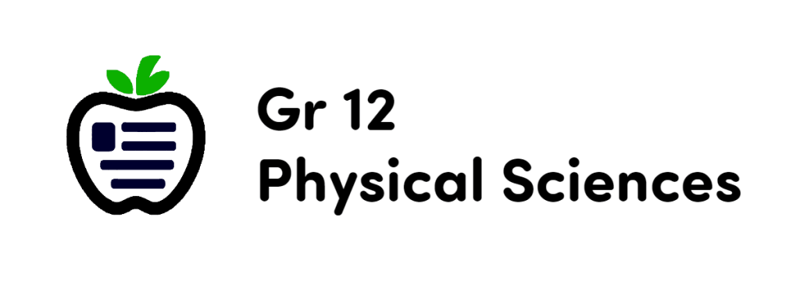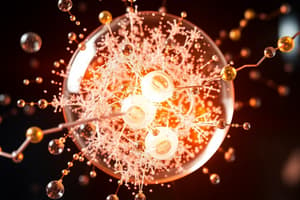Podcast
Questions and Answers
Which of the following factors can increase the rate of a chemical reaction?
Which of the following factors can increase the rate of a chemical reaction?
- Reducing the surface area of the reactants
- Removing the catalyst from the reaction system
- Decreasing the temperature of the reaction mixture
- Increasing the concentration or pressure of reactants (correct)
According to the collision theory, which condition is necessary for a chemical reaction to occur?
According to the collision theory, which condition is necessary for a chemical reaction to occur?
- Reactant particles collide with sufficient energy and correct orientation (correct)
- Reactant particles collide with insufficient energy but correct orientation
- Reactant particles collide with any amount of energy
- Reactant particles collide in any orientation
Which type of reaction releases energy to the surroundings, typically increasing the temperature?
Which type of reaction releases energy to the surroundings, typically increasing the temperature?
- Endothermic reaction
- Exothermic reaction (correct)
- Activation energy reaction
- Catalyst-induced reaction
What is the minimum energy barrier that must be overcome for reactants to transform into products?
What is the minimum energy barrier that must be overcome for reactants to transform into products?
Which experimental technique is useful for measuring the rate of a reaction that produces a gas as a product?
Which experimental technique is useful for measuring the rate of a reaction that produces a gas as a product?
What is the role of a catalyst in a chemical reaction?
What is the role of a catalyst in a chemical reaction?
Which experimental technique is suitable for monitoring the change in concentration of reactants or products?
Which experimental technique is suitable for monitoring the change in concentration of reactants or products?
Which type of reaction absorbs energy from the surroundings, resulting in a temperature decrease around the reaction site?
Which type of reaction absorbs energy from the surroundings, resulting in a temperature decrease around the reaction site?
Which experimental technique is suitable for reactions involving a gaseous reactant or product that allows for mass change?
Which experimental technique is suitable for reactions involving a gaseous reactant or product that allows for mass change?
Which of the following factors can decrease the rate of a chemical reaction?
Which of the following factors can decrease the rate of a chemical reaction?
What does the reaction rate quantify in chemistry?
What does the reaction rate quantify in chemistry?
How is the rate of reaction for reactants expressed mathematically?
How is the rate of reaction for reactants expressed mathematically?
Which factor affects the reaction rate by increasing the probability of particle collisions?
Which factor affects the reaction rate by increasing the probability of particle collisions?
What does the negative sign in the rate expression for reactants indicate?
What does the negative sign in the rate expression for reactants indicate?
Why does increasing the surface area of reactants enhance the reaction rate?
Why does increasing the surface area of reactants enhance the reaction rate?
Which factor influences how quickly reactions proceed based on the chemical nature of substances involved?
Which factor influences how quickly reactions proceed based on the chemical nature of substances involved?
In chemical reactions, what does the product rate expression indicate?
In chemical reactions, what does the product rate expression indicate?
How do reactants and products differ in their rate expressions?
How do reactants and products differ in their rate expressions?
'Nature of Reacting Substances' affecting the reaction rate refers to what aspect?
'Nature of Reacting Substances' affecting the reaction rate refers to what aspect?
'Surface Area' plays a significant role in enhancing reaction rates due to what factor?
'Surface Area' plays a significant role in enhancing reaction rates due to what factor?
Which mathematical expression correctly represents the rate of reaction for products?
Which mathematical expression correctly represents the rate of reaction for products?
If the surface area of solid reactants is increased, how will the reaction rate be affected?
If the surface area of solid reactants is increased, how will the reaction rate be affected?
Which factor primarily influences the reaction rate based on the chemical nature of the reacting substances?
Which factor primarily influences the reaction rate based on the chemical nature of the reacting substances?
What does the negative sign in the rate expression for reactants indicate?
What does the negative sign in the rate expression for reactants indicate?
If the rate of a chemical reaction is expressed as $Rate = \frac{\Delta[Products]}{\Delta t}$, what does the rate represent?
If the rate of a chemical reaction is expressed as $Rate = \frac{\Delta[Products]}{\Delta t}$, what does the rate represent?
Which factor would likely decrease the rate of a chemical reaction?
Which factor would likely decrease the rate of a chemical reaction?
If the rate of a chemical reaction is expressed as $Rate = -\frac{\Delta[Reactants]}{\Delta t}$, what does the rate represent?
If the rate of a chemical reaction is expressed as $Rate = -\frac{\Delta[Reactants]}{\Delta t}$, what does the rate represent?
Which experimental technique would be suitable for monitoring the rate of a reaction involving a gaseous product?
Which experimental technique would be suitable for monitoring the rate of a reaction involving a gaseous product?
Which statement is true regarding the effect of surface area on reaction rates?
Which statement is true regarding the effect of surface area on reaction rates?
Which factor primarily influences the reaction rate based on the chemical nature of the reacting substances?
Which factor primarily influences the reaction rate based on the chemical nature of the reacting substances?
What effect does increasing the temperature typically have on a chemical reaction?
What effect does increasing the temperature typically have on a chemical reaction?
How do catalysts affect the activation energy required for a reaction?
How do catalysts affect the activation energy required for a reaction?
Which factor plays a crucial role in explaining why increasing temperature or concentration can increase reaction rates?
Which factor plays a crucial role in explaining why increasing temperature or concentration can increase reaction rates?
In which type of reaction is energy absorbed from the surroundings, resulting in a temperature decrease at the reaction site?
In which type of reaction is energy absorbed from the surroundings, resulting in a temperature decrease at the reaction site?
What does the concept of activation energy represent in chemical reactions?
What does the concept of activation energy represent in chemical reactions?
Which experimental approach is suitable for observing changes in color or turbidity as an indicator of reaction progress?
Which experimental approach is suitable for observing changes in color or turbidity as an indicator of reaction progress?
In exothermic reactions, what happens to energy during the process?
In exothermic reactions, what happens to energy during the process?
What effect does an increase in concentration have on reaction rates?
What effect does an increase in concentration have on reaction rates?
What does the negative sign in the rate expression for reactants signify?
What does the negative sign in the rate expression for reactants signify?
How does increasing the surface area of reactants impact the reaction rate?
How does increasing the surface area of reactants impact the reaction rate?
In chemical reactions, what does the product rate expression indicate?
In chemical reactions, what does the product rate expression indicate?
Which factor primarily influences the rate of chemical reactions based on the chemical nature of the reacting substances?
Which factor primarily influences the rate of chemical reactions based on the chemical nature of the reacting substances?
What is the role of a catalyst in a chemical reaction?
What is the role of a catalyst in a chemical reaction?
How can the reaction rate be mathematically expressed for products?
How can the reaction rate be mathematically expressed for products?
According to the passage, which of the following is the primary reason that increasing the temperature typically increases the reaction rate?
According to the passage, which of the following is the primary reason that increasing the temperature typically increases the reaction rate?
Based on the information in the passage, what is the primary role of a catalyst in a chemical reaction?
Based on the information in the passage, what is the primary role of a catalyst in a chemical reaction?
According to the collision theory described in the passage, which of the following conditions is necessary for a chemical reaction to occur?
According to the collision theory described in the passage, which of the following conditions is necessary for a chemical reaction to occur?
Which of the following experimental techniques would be most suitable for measuring the rate of a reaction that produces a gaseous product?
Which of the following experimental techniques would be most suitable for measuring the rate of a reaction that produces a gaseous product?
What does the negative sign in the rate expression $Rate = -rac{\Delta[Reactants]}{\Delta t}$ indicate?
What does the negative sign in the rate expression $Rate = -rac{\Delta[Reactants]}{\Delta t}$ indicate?
Which type of chemical reaction, as described in the passage, absorbs energy from the surroundings and results in a temperature decrease around the reaction site?
Which type of chemical reaction, as described in the passage, absorbs energy from the surroundings and results in a temperature decrease around the reaction site?
How does the passage describe the relationship between the rate of reaction for reactants and the rate of reaction for products?
How does the passage describe the relationship between the rate of reaction for reactants and the rate of reaction for products?
Which of the following factors, according to the passage, is the primary influence on the reaction rate based on the chemical nature of the reacting substances?
Which of the following factors, according to the passage, is the primary influence on the reaction rate based on the chemical nature of the reacting substances?
What does the concept of activation energy, as described in the passage, represent in chemical reactions?
What does the concept of activation energy, as described in the passage, represent in chemical reactions?
Which experimental technique described in the passage would be most suitable for observing changes in color or turbidity as an indicator of reaction progress?
Which experimental technique described in the passage would be most suitable for observing changes in color or turbidity as an indicator of reaction progress?




